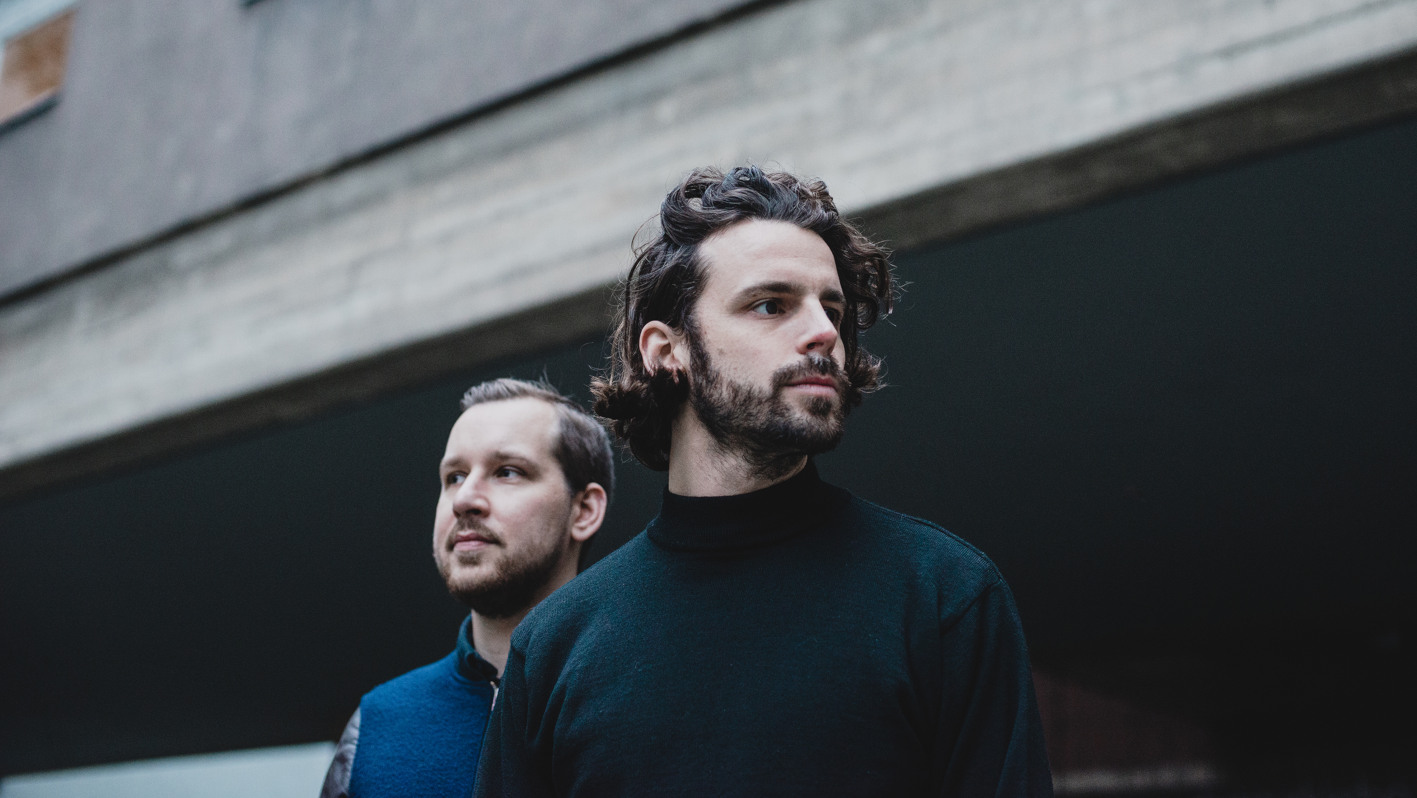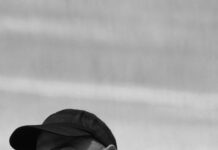Photo: Kasia Zacharko (Artefakt)
There’s many duos in the world of dance music, but few seem to combine their respective talents as well as Artefakt. Ever since their first EP for Delsin in 2015, Nick Lapien and Robin Koek have proven to complement each other perfectly, crafting a techno sound that is rich in textures and accompanied by visuals that whether abstract or concrete seem to mirror perfectly the moods and sonic palettes their music draws on. Having just released their second LP on the Spanish Semantica imprint, their mix for our Groove podcast sees the two Berlin-based producers and De Stijl founders “look forward by looking back”, as they put it.
Your new Monsoon LP for Semantica again features distinct atmospheric sounds, however the general mood seems to have darkened a little in comparison to its predecessor Kinship. How did the record come together?
Monsoon came together over a year long of sound experiments and studio sessions, integrating personal recordings in different layers of abstraction to support a sonic architecture of atmosphere and texture. We aspired to put sound itself as the center for this album and technically expand our own horizons while doing so. Innovating our studio processes and also migrating our studio within Berlin gave new inspiration and introduced a new angle in comparison to the first LP on Delsin. Conceptually, Monsoon draws inspiration from a darker, moody, cloudy place. The artwork very much reflects this and is a perfect visual representation of the mood we wanted to catch in our music— layered, gloomy, dense but wide open— as sonic landscape to get lost in.
As you have already made clear in your Off The Tracks feature in Groove two years ago, nature plays are a significant part for you personally and as musicians. Robin contributes a lot of field recordings to your music, although these are never explicit: there’s no pouring rain, no waterfalls, no sea waves, no chirping insects – at least not in a recognisable form. How do you work field recordings into the music when in the studio?
There are different approaches and techniques we adopt to weave field recordings into our music. We often use the field records of various environments to add textures to, for example, a pad or atmospheric synthesizer. This layering of acousmatic recordings creates a more rich sounding texture that we could not establish solely by means of synthesis, it gives a sense of place and depth without immediately suggestion a certain source of identification.
Another technique that we have used frequently on the latest album is the extraction of rhythms from field recordings. We find a naturally occurring rhythm in a recording – this could be a recording of water dripping, or birds calling – and we use this as a starting point for a rhythmical layer. At times we quantize it and process it, to fit it into the track we are working on and other moments we preserve the free timing.
Also Nick contributes to the aesthetics of Artefakt in more than one way – some of your releases feature his photos as cover artwork. Which importance do visuals have in the cosmos of Artefakt and how do you select which picture works well with a record?
We consider Artefakt to be more than just a techno moniker under which we release club tracks. The ambient tracks, art projects artwork and field recordings are all part of the same aesthetic. During our trips in nature we record field recordings, take photos and get inspired to get back into the studio. This feeds back into our music and accompanying artwork. It’s a constant exchange, rather than “finding the right picture” after the music is done.
You have recently launched your own label, De Stijl. After its first release, your Far and Wide EP, contributions by Rhine and Cyspe – two of your respective solo projects – will follow. What is the concept of the label, which supposedly takes its name from the early 20th century De Stijl art movement?
We wanted to create a platform in which we can further explore the boundaries of sound – both by releasing our own music and music from close friends that share the same aesthetic. De Stijl also allows us to express ourselves fully and without restrictions, both sonically, visually and conceptually. Besides that, it is fantastic to be able to offer a platform to artists that you believe in, and want the world to know about.
Visual input is also important during your composition and recording process – you’ve stated previously that you occasionally would look at selected artworks while making music. How does this structure your creative process – do you approach these pieces as a sort of score, do you try to emulate certain structures with sound or do you rather aim for a certain evoked by the art?
These artworks tend to feed into a creative surrounding or mood more from a impressionist level. We are both big cinephiles and there is a lot of inspiration pouring into the studio be it from the surreal landscapes of Tarkovsky infusing into shimmery elusive pads as well as the eery worlds of Lynch resonating into unearthing glacial melodies. We also take inspiration from the architecture of unique buildings sites and imagine how one can translate the rhythmical cadence in the facades and contrasting composition of material structures into a musical framework.
While you also play DJ sets together, you mostly tour as a live act working with analogue equipment. While there has been a discussion about the needs of vinyl DJs in this day and age, the same cannot be said about live acts. What are common problems that you encounter as touring live musicians – and how could clubs and promoters avoid them?
There are some practical problems we often have to deal with, depending on the resources and creativity of the venue and technical staff these can either resolved on the spot or we have to find a compromise in our performance. We do often encounter clubs which are not primarily designed for extensive live setu-ps. The DJ booth is typically central in the layout of a club and often there is limited space to build up the live set-up. Building up on the side of the DJ booth leads to suboptimal monitoring conditions or moments where it is impossible to truly read and face the audience, resulting in a disconnection. So a recurring challenge is the spatial configuration and another common challenge is the signal routing infrastructure within a performance space which is not designed to intuitively change between live and DJ performances on a night, which might cause transitions to go rough in between or lead to a complete silence when cables need to be re-patched. Most problems can simply be avoided by reading the rider — missing cables, stands, etc. Luckily, most promoters take live sets seriously and accommodate us well. And with a bit of flexibility, it always works out in the end.
What was the idea behind your contribution to the Groove podcast?
In this mix, we wanted to “look forward by looking back”. Before we started releasing as Artefakt, we a shared love for IDM, Electro, Wave, Acid and Deep House from the late 80s and 90s. Looking back, this music had a huge influence in developing our sound. In this mix we feature some of our favourite tracks from that time, alongside our own tracks and tracks from more contemporary producers. These sonic pillars are now the foundation of our label De Stijl and we also wanted to use this mix to reveal the narrative and background to the label.
Last but not least: Where can we see you perform in the near future and what are your plans as producers and label owners?
We are currently readying De Stijl 02, which will features tracks by Northern Electronics affiliate Korridor, tracks by Greek producers Aphelion and Artificial Drm, and one Artefakt track. All producers are close friends that we have made music with in some capacity. We are also working on new original Artefakt EP that is due to come out after the summer. After a small summer break, we are playing a fully improvised live show as a part of the Equations Collective in the garden of ://about:blank on the 31th of August.
Stream: Artefakt – Groove Podcast 218
01. Deep Space Network Meets Higher Intelligence Agency – Chai (Source Records)
02. Higher Intelligence Agency & Biosphere – Gas Street Basin (Headphone)
03. CiM – Comfort Control (Delsin Records)
04. Plastikman – Are Friends Electrik? (NovaMute)
05. Fugue – Contrapoint (Likemind)
06. Artefakt – Levity (De Stijl)
07. Mik Poynter – Elysium Groove (Ugly Music)
08. Dan Curtin – Population II (Peacefrog Records)
09. Deixis – Form.v2 (Abstract Forms)
10. Convextion – Miranda (Matrix Records)
11. Stojche – Contrast (Tangible Assets)
12. Darren Price – Set-up System (NovaMute)
13. Skee Mask – 800AB (Ilian Tape)
14. Chaos AD – Mind War Electro (Rephlex)
15. Daniel Avery – Hyper Detail (Phantasy Sound)
16- Illegal District – Arise (Arise Mix) (Save The Vinyl)
17. Aponogeton – Consolation for Martiška (STROOM)





